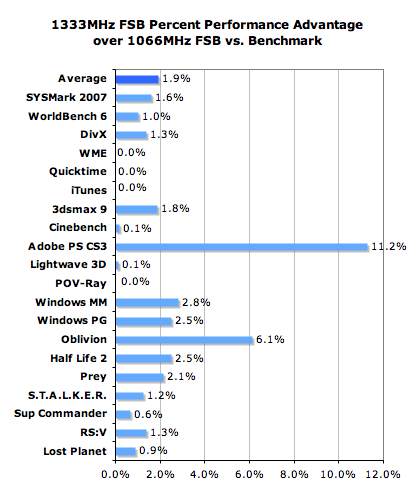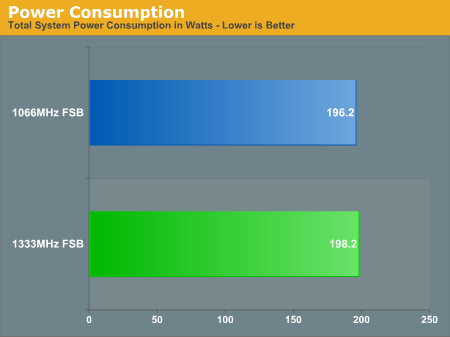Intel Core 2 Duo E6750 Preview: The Desktop Gets a 1333MHz FSB
by Anand Lal Shimpi on June 25, 2007 2:57 AM EST- Posted in
- CPUs
Tell it To Me Straight Anand: Is it Any faster?
The beauty of these FSB launches at equivalent clock speeds is that we show you a single chart that summarizes the performance impact of the faster FSB across our entire bench suite. At one single glance you can figure out whether or not there's anything worth getting excited about:

Overall, the 1333MHz FSB doesn't do much for dual core processors. Over the 20 benchmarks we sampled for this chart, the 1333MHz FSB gave us an average improvement of 1.9% over the 1066MHz FSB. There are two unique outliers in the chart: Oblivion with a 6.1% improvement and Photoshop CS3 with an 11.2% increase in performance. Both of these benchmarks are hand timed so the variance between runs is greater than normal, and we suspect that may be the reason for some of the larger than normal impact of the faster FSB but after multiple subsequent runs we were left with the same results.
Keep in mind the fundamental rules of FSB performance: clock speed, number of cores, memory bandwidth and microprocessor architecture all play important roles in the impact of a faster FSB. The clock speeds Intel is launching its 1333MHz FSB processors are basically the same ones that Intel first introduced the Core 2 at; we weren't FSB bottlenecked back then, thus there's no reason to expect a huge increase in performance by bumping the FSB today. Quad-core CPUs may see a performance boost, but we'll have to wait until later to find out exactly what that improvement would be; we have a feeling that the overall performance impact will be similarly unimpressive given the relatively limited number of desktop applications that can take full advantage of four cores.
As Intel ramps up clock speed and continues its transition to quad-core the 1333MHz FSB will be more important, but today it's by no means a necessary feature. There's a bigger performance impact from having more L2 cache (e.g. 4MB vs. 2MB) than from the 1333MHz FSB, which is great news for present day Core 2 owners.
Under load, the faster FSB also doesn't increase power consumption much at all:

An increase of 2W isn't much for a desktop platform, although Intel could arguably implement a variable speed FSB from its latest Centrino platform if power consumption ever becomes an issue.










42 Comments
View All Comments
Anand Lal Shimpi - Monday, June 25, 2007 - link
Hmm that link didn't work out, lemme try again:http://www.anandtech.com/cpuchipsets/intel/showdoc...">http://www.anandtech.com/cpuchipsets/intel/showdoc...
ncage - Monday, June 25, 2007 - link
Ummm everyone wants a new cpu tested for their specific circumstance. Testing the encoding performance you talk of would be a very big task in itself. Think of all the possibilites that could be tested with all the different encoders and even a specific version of an encoder could make a big difference (how parallel the code is in that version). It would be an impossible task for them to make everyone happy. I think anandtech does exactly what they need to do. They test a variety of applications and give you a sense for "General" performance of the cpu. If you look at any cpu review people will say...why didn't you do this test why didn't you do that test. I would just be happy with what you get.Ncage
7oby - Monday, June 25, 2007 - link
definitely, however as a starting point, take these:
http://www.tomshardware.com/2007/03/26/the_gigaher...">http://www.tomshardware.com/2007/03/26/the_gigaher...
http://hardware.thgweb.de/2007/04/09/intel_core_2_...">http://hardware.thgweb.de/2007/04/09/in...reme_qx6...
http://www23.tomshardware.com/cpu.html">http://www23.tomshardware.com/cpu.html
[sorry, all more or less from the same site]
Depending on their degree of parallelizm the de-/encoder applications take different advantages of multi cores. Some do not yet scale beyond dual cores. Still a quad core can make perfectly sense:
. even if your particular video encoder can benefit only from two cores, then just throw two videos simultaneously at the quad core. It will scale ;-)
. while encoding there are still resources left for other tasks you might want to do while encoding
. its very likely that future versions of current encoding codecs will scale better with multi cores as soon as those processors become more mainstream and the demand for this requirement raises. Besides - look just as an illustrating example at OpenMP: It may be hard at the beginning to parallize your application, but going from 2 way to 4 way is not that hard anymore. In the simple case of OpenMP you get it for free. Image and video processing scales particularly good with # of processors: you either partition the image into blocks or distribute the different encoding stages.
7oby
TA152H - Monday, June 25, 2007 - link
Ummmm, I couldn't care less how well it performs on a quad-core, since I have absolutely no intention of buying one in the near future. Most people here will do fine with a dual-core, and the market share for quad cores is very low by comparison. Thus, he picked something that makes sense since it will target more people.TA152H - Monday, June 25, 2007 - link
First of all, why use DDR2 on a 1333 FSB processor? Wouldn't it have been more interesting to show these processors running on DDR3 running at 1333 MHz, instead of DDR2-800 ? It looks like the memory was run at only 800 MHz in both cases, so it's not at all surprising the results weren't enormous, actually it's pretty surprising that the results were as much better than they are. If you ran them each with appropriate memory, you'd probably see the reason for moving to 1333 FSB a lot more clearly. It surely wasn't to run memory at 800 MHz with it.I'm not criticizing doing a DDR2 800 MHz review because it does show something, but making it the only tests misses the point. It's more interesting academically, so should be included, but in terms of real world use, it's not very revealing. I suspect most people wanting these processors will not want to shackle it with DDR2-800 MHz memory. And before cost is brought up, keep in mind the processor will not be out for a few months, and the cost of DDR3 right now is not what it will cost then. Clearly it should fall closer to DDR2 as time goes along, so I think it's worth testing to see the true performance increase of the platform.
coldpower27 - Monday, June 25, 2007 - link
I don't see why, as Dual Channel DDR2-800 would provide enough bandwidth to feed a theoretical FSB1600 processor let alone FSB1333. I don't see the point in having memory in a 2:1 ratio with the FSB as DDR3-1333 would be providing exactly 2x the memory bandwidth the processor can take advantage of.As well this processor is coming out in a single month, not a few months, so I wouldn't at all expect DDR3 prices to drop all that much.
I expect DDR3 to provide some performance benefits, but nothing earth shattering compared to the DDR2 as your providing more memory bandwidth then the FSB can handle.
mostlyprudent - Monday, June 25, 2007 - link
I seem to recall an article here on Anandtech.com about 6-8 months ago that demonstrated a "noticable" performance improvement going from DDR2-667 to DDR2-800 on the Core 2 Duo line of processors. I also wonder if we would see a noticable performance improvement on native 1333 FSB CPU running faster DDR2 or DDR3.coldpower27 - Monday, June 25, 2007 - link
http://images.anandtech.com/reviews/memory/ddr2/20...">http://images.anandtech.com/reviews/memory/ddr2/20...I don't see much of a noticable improvement here on Core 2, Core just hasn't shown much signs if any of being dramatically affected by memory speed.
TA152H - Monday, June 25, 2007 - link
Are you serious?Did you read the initial article they wrote on the P35? Then the follow up which showed how much of it was because of the increase in the memory speed. Just about every article on DDR3 shows that it needs higher clock speeds to show real performance. Yet, it wouldn't make any difference here? That makes no sense at all. Besides, if you're getting an improvement by just increasing the FSB and not the memory, that's very interesting indeed. With increased memory speed, you're going to see a pronounced improvement. I'm still surprised there's as much a difference as there was with the same exact memory running at the same speed. Faster DDR3 memory should blow show why Intel went to 1333. DDR2 800 won't.
coldpower27 - Wednesday, June 27, 2007 - link
I am dead serious I don't see much of a performance improvement on the whole. Anyway the results provided on the P35 Chipset cannot be used unless you isolate the variable of memory speed and chipset. So you need to compare DDR2-800 with a 1.33GHZ FSB on the P35 Chipset to DDR3-1333 with a 1.33GHZ FSB on the P35 Chipset to generate any useful data.Not particularly most of the benches show that DDR2-800 is about the level of DDR3-1066 due to it's added latency. DDR3-1333 would be somewhat faster but not any dramatic increase as your trying to paint.
The reason they moved to DDR3/P35 and 1.33GHZ FSB all at the same time (relatively), was because all 3 were needed to generate a worthwhile performance improvement.